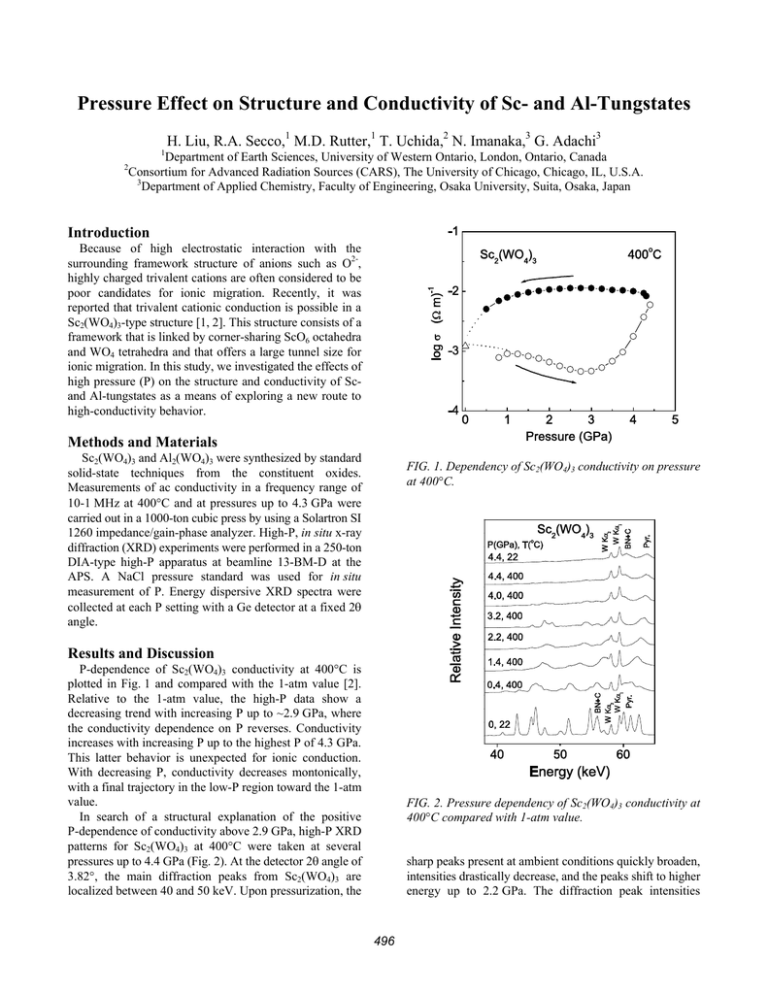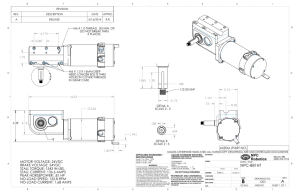Pressure Effect on Structure and Conductivity of Sc- and Al-Tungstates
advertisement

Pressure Effect on Structure and Conductivity of Sc- and Al-Tungstates H. Liu, R.A. Secco,1 M.D. Rutter,1 T. Uchida,2 N. Imanaka,3 G. Adachi3 1 Department of Earth Sciences, University of Western Ontario, London, Ontario, Canada Consortium for Advanced Radiation Sources (CARS), The University of Chicago, Chicago, IL, U.S.A. 3 Department of Applied Chemistry, Faculty of Engineering, Osaka University, Suita, Osaka, Japan 2 Introduction Because of high electrostatic interaction with the surrounding framework structure of anions such as O2-, highly charged trivalent cations are often considered to be poor candidates for ionic migration. Recently, it was reported that trivalent cationic conduction is possible in a Sc2(WO4)3-type structure [1, 2]. This structure consists of a framework that is linked by corner-sharing ScO6 octahedra and WO4 tetrahedra and that offers a large tunnel size for ionic migration. In this study, we investigated the effects of high pressure (P) on the structure and conductivity of Scand Al-tungstates as a means of exploring a new route to high-conductivity behavior. Methods and Materials Sc2(WO4)3 and Al2(WO4)3 were synthesized by standard solid-state techniques from the constituent oxides. Measurements of ac conductivity in a frequency range of 10-1 MHz at 400°C and at pressures up to 4.3 GPa were carried out in a 1000-ton cubic press by using a Solartron SI 1260 impedance/gain-phase analyzer. High-P, in situ x-ray diffraction (XRD) experiments were performed in a 250-ton DIA-type high-P apparatus at beamline 13-BM-D at the APS. A NaCl pressure standard was used for in situ measurement of P. Energy dispersive XRD spectra were collected at each P setting with a Ge detector at a fixed 2θ angle. FIG. 1. Dependency of Sc2(WO4)3 conductivity on pressure at 400°C. Results and Discussion P-dependence of Sc2(WO4)3 conductivity at 400°C is plotted in Fig. 1 and compared with the 1-atm value [2]. Relative to the 1-atm value, the high-P data show a decreasing trend with increasing P up to ~2.9 GPa, where the conductivity dependence on P reverses. Conductivity increases with increasing P up to the highest P of 4.3 GPa. This latter behavior is unexpected for ionic conduction. With decreasing P, conductivity decreases montonically, with a final trajectory in the low-P region toward the 1-atm value. In search of a structural explanation of the positive P-dependence of conductivity above 2.9 GPa, high-P XRD patterns for Sc2(WO4)3 at 400°C were taken at several pressures up to 4.4 GPa (Fig. 2). At the detector 2θ angle of 3.82°, the main diffraction peaks from Sc2(WO4)3 are localized between 40 and 50 keV. Upon pressurization, the FIG. 2. Pressure dependency of Sc2(WO4)3 conductivity at 400°C compared with 1-atm value. sharp peaks present at ambient conditions quickly broaden, intensities drastically decrease, and the peaks shift to higher energy up to 2.2 GPa. The diffraction peak intensities 496 decrease again with a further increase in P up to 4.4 GPa, when all diffraction peaks from the sample are absent. The decrease in peak intensity and broadening in peak shape observed for Sc2(WO4)3 with increasing pressure is interpreted as gradual P-induced amorphization. The Sc2(WO4)3 belongs to a relatively small class of substances with a negative thermal expansion coefficient [3, 4]. The structure of Sc2(WO4)3 consists of ScO6 octahedra and WO4 tetrahedra linked through corner-sharing to form a 3-D framework [5, 6]. The negative value of expansion is related to transverse vibrations of bridging oxygens in the Sc-O-W linkages [3, 4]. Anharmonicity in these vibrations leads to cooperative tilting of the quasi-rigid framework polyhedra, causing an effective decrease in the average Sc-O-W bridging bond angle and a concomitant densification upon heating. The complex coupled twisting in three dimensions of the relatively rigid framework polyhedra upon heating provides a possible route to P-induced disorder [7]. The overall 3-D framework structure can perhaps be best understood by breaking it down into 2-D slabs of cornersharing polyhedra parallel to the a-c plane, which stack together to form the overall structure. The c and a axes are more compressible than the b axis on the basis of the flexible hinged Sc-O octahedra and W-O tetrahedra linkages. The Sc-O-W angles in the polyhedra within the a-c plane are affected the most by P. This leads to the polyhedra exhibiting a higher degree of anisotropy in the a-c plane relative to either the b-c or the a-b plane. This degree of anisotropy increases with compression, until the rigid polyhedra begin to oppose each other. The forces that tend to keep polyhedra regular are mainly the oxygen-oxygen repulsive interactions within the polyhedron. To accommodate further volume reduction as P is increased, the polyhedra must rotate or tilt and eventually rupture the flexible Sc-O-W linkages. This is macroscopically identified as amorphization. The conductivity results at P above 2.9 GPa suggest that amorphization enhances conduction. We interpret this to be the result of the increase in structural entropy and its concomitant effects on accessibility of neighboring sites to mobile Sc3+. The association of pressure-induced amorphization behavior and negative thermal expansion behavior, as well as the unexpected conductivity behavior in Sc2(WO4)3, led us to investigate the pressure behavior of Al2(WO4)3 which is iso-structural with Sc2(WO4)3 but has a positive thermal expansion behavior. The results of high-P XRD showed that the structure remains crystalline up to the maximum experimental pressure. The pressure dependences of the lattice parameters a, c, calculated from XRD patterns at 400°C, are shown in Fig. 3. All parameters exhibit a normal decrease with an increase in pressure below 2.5 GPa. However, an obvious change occurs at pressures between 2.8 and 3.2 GPa for all lattice parameters. The two short crystallographic axes, a and c, of the orthorhombic unit cell approach one another in this critical pressure region, and FIG. 3. Pressure dependencies of lattice parameters a, c calculated from XRD patterns at 400°C. they remain approximately equal upon any further increase of pressure. This signals a pressure-induced structural transition from orthorhombic to tetragonal. In the 3-D Sc2(WO4)3-type framework structure, there are densely populated corner-sharing layers of WO4 tetrahedra and ScO6 octahedra. These layers extend parallel to the a-c plane and stack together along the b direction only through O(3) to form the overall structure [3]. Such a stacking results in the b axis being more compressible than the a and c axes at pressure. Conductivity data (Fig. 4) also show clearly that Al2(WO4)3 exhibits very different behavior at high P than does Sc2(WO4)3. Conductivity increases very fast with increasing pressure below 2.0 GPa, then slowly increases and reaches a maximum value of ~1.6 × 10-2 (ohm · cm-1), which is about five orders of magnitude greater than the 1-atm value, at pressures close to 4.0 GPa. Upon decreasing pressure, conductivity remains constant until a pressure of 0.5 GPa, when the sample cooled down from 400°C to room temperature. Since the dramatic change in conductivity occurs below 2.0 GPa, it cannot be attributed to the structural change at 2.5 GPa. The measurement of dc polarization reveals that electrical conduction in Al2(WO4)3 has been changed from ionic dominant to electronic dominant at high P. Mixed valence states of W6+ and W5+ have been observed in the bronzes [Ax(P2O4)2(WO3)2m], NaxWO3, and other crystalline and glass tungsten oxides [9-11]. The presence of mixed-valent W causes a delocalization of the electrons over the polyhedral framework. These materials exhibit metallic, electronically conducting properties. The concentration of the lower valence state, W5+, and therefore the conductivity, is strongly influenced by octahedral ion substitution or the environmental atmosphere [10, 11]. The high-P closed environment, with the sample encapsulated in BN, is a reducing atmosphere that is oxygen deficient. Therefore, the 497 Energy Sciences, under Contract No. W-31-109-ENG-38. We thank R. Tucker for preparation of the high-P cells and M. Rivers and S. Sutton for technical support. This work was supported by the Sumitomo Foundation of Japan (Grant No. 000513) to N. Imanaka and R. A. Secco and by Natural Sciences and Engineering Research Council of Canada (NSERC) and University of Western Ontario (ADF Program) grants to R. A. Secco. References [1] J. Koehler, N. Imanaka, and G. Adachi, Chem. Mater. 10, 3790 (1998). [2] N. Imanaka, Y. Kobayashi, K. Fujiwara, T. Asano, Y. Okazaki, and G. Adachi, Chem. Mater. 10, 2006 (1998). [3] J. S. Evans et al., J. Solid State Chem. 137, 148 (1998). [4] A. W. Sleight, Ann.. Rev. Mater. Sci. 28, 29 (1998). [5] S. C. Abrahams and J. L. Bernstein, J. Chem. Phys. 45, 2745 (1966). [6] Y. Piffard et al., J. Solid State Chem. 71, 121 (1987). [7] R. A. Secco, H. Liu, N. Imanaka, and G. Adachi, J. Mater. Sci. Lett. 20, 1339 (2001). [8] N. Imanaka, Y. Kobayashi, S. Tamura, and G. Adachi, Electrochem. Solid-State Lett. 1, 271(1998). [9] C. N. R. Rao, B. Raveau, Transition Metal Oxides, 2nd ed. (Wiley-VCH, 1998), p. 85. [10] R. P. Tandon and S. Hotchandani, Phys. Status Solidi A 185, 453 (2001). [11] P. N. Huang, X. H. Huang, and F. X. Gan, Solid State Ionics 44, 11 (1990). Note: Part of this content has been published in J. Phys. Chem. Solids 63, 425 (2002). FIG. 4. Conductivity data. change in ionic to electronic conduction can then be attributed to the tungsten valence change in Al2(WO4)3 at high P, which results in electron transfer through W5+ → W6+. Acknowledgments High-P XRD was performed at the GeoSoilEnviro Consortium for Advanced Radiation Sources (GSECARS) sector 13. GSECARS is supported by the National Science Foundation (Earth Sciences), U.S. Department of Energy (DOE, Geosciences), W. M. Keck Foundation, and U.S. Department of Agriculture. Use of the APS was supported by the DOE Office of Science, Office of Basic 498


